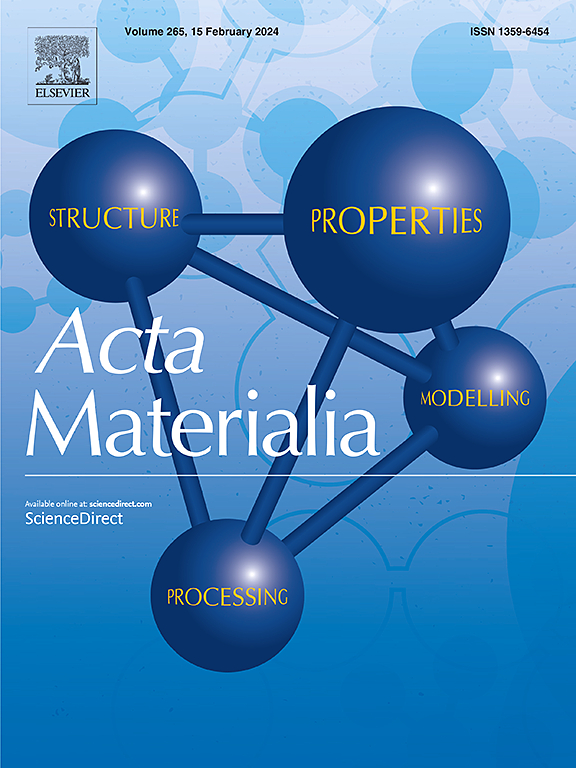Automatic intelligent multiscale simulation to predict mechanical properties and deformation mechanism of complex concentrated alloys
IF 8.3
1区 材料科学
Q1 MATERIALS SCIENCE, MULTIDISCIPLINARY
引用次数: 0
Abstract
Due to differences in atomic interactions, chemical heterogeneous structures are inevitably formed, especially in complex concentrated alloys, which strongly influences their mechanical behaviors and properties. However, existing continuum mechanics models fail to consider key mechanical information on characteristics of atoms themselves and their interactions, and simultaneously bridge discrete atomic scale with continuum scale remains a great challenge. Here, we propose a general automatic multiscale simulation framework that integrates the approach of machine learning, atomic simulation, dislocation dynamics, crystal plasticity finite element method, and constitutive model for bridging from atomic discrete mechanics to continuum mechanics. The proposed framework mainly focuses on dual physical scales: (i) discrete atomic configuration-dependent nanoscale atomic-level strain tensor, and (ii) continuum theory-based deformation behavior and macroscopic mechanical response. To quantitatively describe atomic-strain-field constrained dislocation behavior, automatic workflow is developed for mesoscale strain field. The atomic discrete scale and dislocation continuum scale are seamlessly connected through simulation framework, enabling overall computational scheme of simultaneously dealing with atomistic effects and mesoscale dislocation movement. The atomic information-guided, machine learning-enabled automatic multiscale simulation is applied to complex concentrated alloys, which achieves an automated and intelligent prediction from atomic structure characteristics to macroscopic mechanical properties and plastic deformation mechanisms. The findings indicate that increasing chemical heterogeneous significantly enhances strain amplitude while broadening the spacing between strain peaks/valleys, resulting in a competition between hardening driven by dislocation cross-slip and softening caused by dislocation motion. The proposed automatic multiscale simulation framework not only creates a bridge between discrete mechanics and continuum mechanics, but also would be extended to other metal systems.


复杂浓缩合金力学性能及变形机理的自动智能多尺度模拟
由于原子相互作用的差异,不可避免地形成化学非均相结构,特别是在复杂的浓缩合金中,这强烈地影响了它们的力学行为和性能。然而,现有的连续介质力学模型没有考虑到原子本身特征及其相互作用的关键力学信息,同时在离散原子尺度和连续介质尺度之间架起桥梁仍然是一个巨大的挑战。在这里,我们提出了一个通用的自动多尺度模拟框架,该框架集成了机器学习、原子模拟、位错动力学、晶体塑性有限元方法和本构模型,用于从原子离散力学到连续力学的桥梁。所提出的框架主要关注双重物理尺度:(i)依赖于离散原子构型的纳米尺度原子级应变张量;(ii)基于连续统理论的变形行为和宏观力学响应。为了定量描述原子应变场约束下的位错行为,建立了中尺度应变场的自动工作流。通过模拟框架将原子离散尺度和位错连续尺度无缝连接,实现了同时处理原子效应和中尺度位错运动的整体计算方案。将原子信息引导、机器学习支持的自动多尺度模拟应用于复杂浓缩合金,实现了从原子结构特征到宏观力学性能和塑性变形机理的自动化、智能化预测。结果表明:化学非均质性的增加显著提高了应变幅值,同时扩大了应变峰谷间距,导致位错交叉滑移导致的硬化与位错运动导致的软化相互竞争;所提出的自动多尺度模拟框架不仅在离散力学和连续力学之间架起了一座桥梁,而且可以推广到其他金属系统。
本文章由计算机程序翻译,如有差异,请以英文原文为准。
求助全文
约1分钟内获得全文
求助全文
来源期刊

Acta Materialia
工程技术-材料科学:综合
CiteScore
16.10
自引率
8.50%
发文量
801
审稿时长
53 days
期刊介绍:
Acta Materialia serves as a platform for publishing full-length, original papers and commissioned overviews that contribute to a profound understanding of the correlation between the processing, structure, and properties of inorganic materials. The journal seeks papers with high impact potential or those that significantly propel the field forward. The scope includes the atomic and molecular arrangements, chemical and electronic structures, and microstructure of materials, focusing on their mechanical or functional behavior across all length scales, including nanostructures.
 求助内容:
求助内容: 应助结果提醒方式:
应助结果提醒方式:


